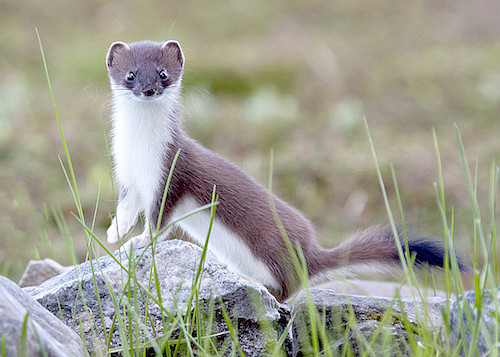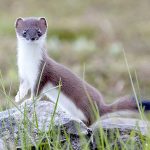

Initial results of Orkney stoat trapping trial revealed

The results of a stoat trapping trial held in Orkney, by the Orkney Native Wildlife Project, were revealed today, with a total of 41 stoats caught across three areas in the county between mid-December and the end of February.
The trial has been designed to help inform plans to remove stoats from areas in the county and in order to protect Orkney’s internationally important wildlife.
The Orkney Native Wildlife Project carried out the trial as part of the nine-month development phase funded by the Heritage Lottery Fund as part of the work to optimise technical aspects of the planned eradication.
The project will be the world’s largest stoat eradication to date and a first for Europe, therefore those behind it have said it was important to test some elements of the methodology to ensure it will be successful and to investigate differences in stoat behaviour in Orkney.
In December 2017, active lethal humane traps were positioned at three trial sites west of Kirkwall – Grimbister, Hobbister and Wideford. In order to determine their effectiveness, a range of trap types and trap housings and a range of habitats were tested. The traps were then checked eight times between mid-December and the end of February with number, gender and trap location of each stoat caught being recorded.
A total of 41 stoats were caught across the three sites with nearly half of those caught at the Grimbister site. Overall, eighty-five per cent of stoats caught were captured in the double set traps, where there were two traps in each box with an entrance at both ends. Traps were set in improved grassland, rough grassland and moorland, with the vast majority of stoats caught in moorland followed by on the edges of moorland and the coast.
The main finding, according to those behind the trial, was that the density of stoats in these three trial areas appears to be high compared to other islands around the world where stoat densities have been estimated during eradications.
The estimated density of stoats in the three Orkney areas was 2-4 per km2 compared to the total density of stoats from Secretary Island and Resolution Island in New Zealand of 1.1-1.4 per km2 and 0.7 per km2, respectively.
It is thought the difference in density is likely to be an underestimate too as the calculated density of stoats caught would be considerably higher over many years of trapping, like that which took place on the New Zealand Islands, compared to the 12-week trapping trial in Orkney. This is the first time that an indication of the abundance of stoats in Orkney has been available.
A subset of the trials will continue in the same areas over the summer to gain data on bait preference and the number of stoats caught in different seasons to help make the density estimates more accurate and get an understanding of whether the habitat and gender data is similar between seasons.
Speaking on behalf of the Orkney Native Wildlife Project, Graham Neville said: “We would like to say a huge thanks to all of the landowners in the three trapping trial areas who have helped this key part of the development of the eradication to occur. The data we have recorded over the winter has helped inform our methodology for trapping during the eradication and given us a first indication of the abundance of stoats on Orkney. We look forward to continuing to work with landowners to gather further information from the continued trials to ensure we deliver the most effective and efficient eradication.”
The Orkney Native Wildlife Project, is a partnership between Scottish Natural Heritage (SNH) and RSPB Scotland, which is supported by the National Lottery through the Heritage Lottery Fund for development. The aims of the project are to protect Orkney’s native wildlife by removing stoats, an invasive non-native predator that was first recorded in Orkney in 2010.
Stoats are native to the UK Mainland but not to Orkney, where they were first recorded in 2010. Since then the population has increased and is now fully established and widely-distributed throughout Mainland Orkney, Burray and South Ronaldsay.
Those at the head of the eradication project have said stoats pose a very serious threat to Orkney’s native wildlife particularly the Orkney vole, hen harrier, short-eared owl and other ground-nesting birds such as red-throated divers, Arctic terns and curlews for which Orkney is internationally important and upon which Orkney’s thriving wildlife tourism industry relies.